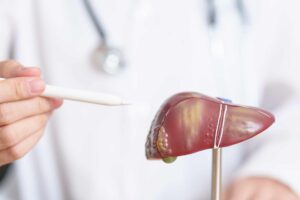Table of Contents
ToggleWhat is already known on this topic
Konzo is a severe neurological disease that results in paralysis. It mostly affects children and women in sub-Saharan Africa, and it occurs after consuming poorly processed cassava — a woody shrub with an edible root that is a staple crop in many low-income countries. Poorly processed cassava contains a compound that, when broken down in the body, releases cyanide — a toxic, potentially deadly chemical. The exact mechanisms underlying konzo susceptibility and severity are poorly understood, but the gut microbiota seems to play a role.
What this research adds
Researchers analyzed the gut microbiota of 180 people from the Democratic Republic of the Congo, where konzo is most frequent. They found that differences in gut bacteria composition between individuals may affect the release of cyanide after poorly processed cassava is consumed. People living in areas with a high prevalence of konzo have increased levels of bacteria and genes that may trigger the activity of enzymes needed for the release of cyanide in the gut.
Conclusions
The findings could help to identify people who are more at risk of developing konzo. The work could also inform targeted interventions to better process cassava or to modify the microbiota in ways that increase protection against konzo.
Konzo is a severe neurological disease that results in paralysis and mostly affects children and women in sub-Saharan Africa. Differences in gut microbiota composition may make some people more susceptible to the disease, a new study has found.
The findings, published in Nature Communications, could help to identify people who are more at risk of developing konzo. The work could also inform targeted interventions to better process cassava or to modify the microbiota in ways that increase protection against konzo. Modifying the composition of bacterial communities in the gut is, however, “a difficult task which may have unintended consequences and other side effects,” says study co-senior author Eric Vilain at Children’s National Hospital in Washington, DC.
Konzo occurs after consuming poorly processed cassava — a woody shrub with an edible root that is a staple crop in many low-income countries. Poorly processed cassava contains a compound that, when broken down in the body, releases cyanide — a toxic, potentially deadly chemical. The exact mechanisms underlying konzo disease susceptibility and severity are poorly understood, but the gut microbiota seems to play a role.
To investigate the gut microbiota of populations that rely on cassava as their primary food source, researchers led by Vilain and Desire Tshala-Katumbay at the Institut National de Recherche Biomédicale in Kinshasa collected fecal samples and dietary questionnaires from 180 people from the Democratic Republic of the Congo, where konzo is most frequent.
Microbial differences
Fecal samples were collected in an urban area without konzo where people don’t consume much cassava, and two rural areas where people consume cassava. One of the rural areas has a low prevalence of konzo and the other has a high prevalence of the disease.
Across all samples, the four most abundant types of gut bacteria were Bacteroidetes, Firmicutes, Proteobacteria, and Actinobacteria. However, the researchers observed some key differences between populations: for example, the microbiota of individuals from urban areas were dominated by bacteria belonging to the Bacteroidaceae family, whereas the predominant bacteria in rural populations living in areas with high prevalence of konzo were Prevotellaceae. People living in regions with low konzo prevalence had a high abundance of Lachnospiraceae in their guts.
Further analyses suggested that differences in gut bacteria composition between individuals can explain the increased disease susceptibility of some people. These differences may affect the release of cyanide after poorly processed cassava is consumed, the researchers found.
People living in areas with a high prevalence of konzo have increased levels of bacteria and genes that may trigger the activity of enzymes needed for the release of cyanide in the gut. On the other hand, people living in areas with a low prevalence of konzo have higher levels of bacteria and genes that may moderate the effects of exposure to cyanide.
Preventing disease
Although the gut microbiota is not the only cause of disease, it is an important factor, the researchers say. They note that without the action of gut microbes, the compounds found in cassava would pose little risk to people.
The new study, Tshala-Katumbay says, “will open novel avenues to prevent konzo, a devastating disease for many children in Sub-Saharan Africa.” However, more work is needed to identify which gut microbes may be a target to mitigate individual susceptibility to konzo.
Next, the researchers plan to study sibling pairs where only one sibling develops the disease. “Studying siblings will help us control for factors that cannot be controlled otherwise, such as the cassava preparation in the household,” says study co-author Neerja Vashist. “This study design will allow us to confirm that the trends we observed hold on a larger scale, while enhancing our ability to comprehensively characterize the gut microbiome.”











